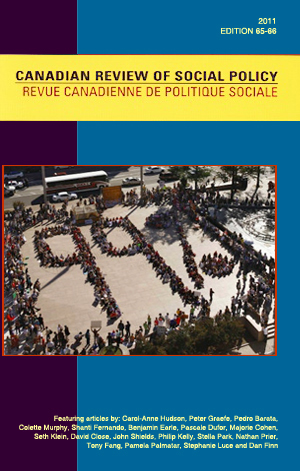Profiling Immigrant Poverty in Canada: A 2006 Census Statistical Portrait
Résumé
This study uses 2006 Canadian census data to examine the incidence of poverty in immigrant communities in Canada, both at the national and Census Metropolitan Area (CMA) scales. Using before-tax Low Income Cut-Offs (LICO) as a measure, this analysis dissects the impact of time of arrival, age, marital status, racialization, and geographic setting in describing the Canadian immigrant experience of poverty. More recent immigrants appear to face a comparatively difficult entry into the Canadian labour market, though other factors such as age and marital status complicate this conclusion. Racialization also plays a role in determining the likelihood of poverty among Canadian immigrants, though not across all categories and contexts. Geography is also a key consideration here, where poverty is usually an urban phenomenon, particularly in the major gateway cities. While the overall conclusion is immigrants are more likely to be in poverty than the Canadian-born, this study demonstrates that this is a complex phenomenon with a number of variables that need to be considered. Cette étude est fondée sur les données du recensement canadien de 2006. Elle vise à mesurer la pauvreté dans les communautés immigrantes au Canada, à la fois au niveau national et à l'échelle de la région métropolitaine de recensement (RMR). En s’appuyant sur le seuil de faible revenu (SFR) avant impôts, elle analyse l'effet de la date d'arrivée, de l'âge, de la situation de famille, de la racialisation et du milieu géographique sur la pauvreté au sein des communautés immigrantes au Canada. Les immigrants qui sont arrivés dernièrement semblent s’intégrer plus difficilement au sein du marché du travail canadien, même si d'autres facteurs, tels que l'âge et la situation familiale, viennent nuancer cette conclusion. La racialisation joue également un rôle quand on cherche à déterminer la probabilité qu’un immigrant au Canada devienne pauvre, même si ce phénomène ne touche pas toutes les catégories ni toutes les situations. La géographie constitue également un facteur essentiel : la pauvreté est en général un phénomène urbain, en particulier dans les principales villes carrefours. Même si la conclusion générale semble indiquer que les immigrants sont plus enclins à devenir pauvres que les citoyens nés au Canada, cette étude démontre qu'il s'agit d'un phénomène complexe s'accompagnant de nombreuses variables qui doivent être prises en compte.Publié-e
Comment citer
Numéro
Rubrique
Licence
1-The author guarantees that the manuscript is an original work not published elsewhere in print or electronically in whole or in part, except in abstract form, that the author has the full power to make this contribution, and that the manuscript contains no matter libelous or otherwise unlawful or which invades the right of privacy or which infringes any proprietary right.
2-The author guarantees that the manuscript has not been previously published in print or electronically and that if the manuscript contains any tables, figures or images fully reproduced or closely adapted from previously published material, the author must obtain the necessary permission from the author/publisher holding the original copyright prior to publication in CRSP. The author may be required to produce evidence of permission granted to CRSP’s editors.
3-As a condition of publication in CRSP, the author assigns all copyright to CRSP, including but not limited to the right to publish, republish, and otherwise distribute this manuscript in print, electronic, or other formats. As CRSP is a non-profit interdisciplinary scholarly journal, the author will receive no royalty or other monetary compensation for the assignment set forth in this agreement.
For the purpose of full disclosure, CRSP will not normally use the content provided by the author in a commercial venture, but for the purpose of disseminating the author’s content to as many readers as possible. For distribution, third parties engaging in commercial activities may be contracted to distribute the content globally, and such parties may make a profit out of the author’s content in their normal course of business. CRSP will not pay the author or reimburse the author in any form based on such commercial activities because the conduct of such commercial activities is outside the control of CRSP.
Any future reference to or use of this published material by the authors must acknowledge CRSP as the original place of publication.
PERMISSION REQUEST/ARCHIVING
Permission is given to author(s) receiving funding via Tri-Council Agencies, the Canadian Institutes of Health Research (CIHR), the Natural Sciences and Engineering Research Council of Canada (NSERC) and the Social Sciences and Humanities Research Council (SSHRC), to make their publications freely available in an Open Access repository within the stated deadline by the Tri-Council Agencies (12 months following publication). Archiving of publication must be a manuscript copy bearing none of the CRSP headers, footers or any other distinguishing marks. No links to the article on the CRSP website is permitted.
Permission requests from third parties to reproduce articles in part or full in academic/educational publications can be directed to the managing editor of CRSP, and will not be unreasonably denied.

